Asiatic cheetah
| Asiatic cheetah | |
|---|---|
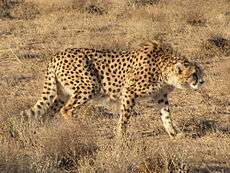 | |
| An Asiatic cheetah in Miandasht Wildlife Refuge, Iran, 2010 | |
| Scientific classification | |
| Kingdom: | Animalia |
| Phylum: | Chordata |
| Class: | Mammalia |
| Order: | Carnivora |
| Suborder: | Feliformia |
| Family: | Felidae |
| Subfamily: | Felinae |
| Genus: | Acinonyx |
| Species: | A. jubatus |
| Subspecies: | A. j. venaticus |
| Trinomial name | |
| Acinonyx jubatus venaticus (Griffith, 1821) | |
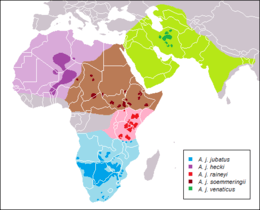 | |
| A. j. venaticus range (green) | |
| Synonyms[2] | |
|
A. j. venator Brookes, 1828 | |
The Asiatic cheetah (Acinonyx jubatus venaticus), also known as Iranian or Persian cheetah, is a Critically Endangered cheetah subspecies surviving today only in Iran.[1] It once occurred from the Arabian Peninsula and the Near East[3] to the Kyzylkum Desert, Caspian region, Pakistan and India, but has been extirpated there during the 20th century.[4][5]
The Asiatic cheetah survives in protected areas in the eastern-central arid region of Iran, where the human population density is very low.[6] Between December 2011 and November 2013, 84 individuals were sighted in 14 different protected areas, and 82 individuals were identified from camera trap photographs.[7][8] As of December 2017, fewer than 50 individuals are thought to be remaining in three subpopulations that are scattered over 140,000 km2 (54,000 sq mi) in Iran’s central plateau.[9] In order to raise international awareness for the conservation of the Asiatic cheetah, an illustration was used on the jerseys of the Iran national football team at the 2014 FIFA World Cup.[10]
The Asiatic cheetah separated from its African relative between 32,000 and 67,000 years ago.[11] During the British colonial times in India, it was called hunting leopard, a name derived from the ones that were kept in captivity in large numbers by Indian royalty to use for hunting wild antelopes.[12]
Taxonomy
The Indian cheetah was proposed as a subspecies by British zoologist Edward Griffith in 1821.[4] Griffith's description of Felis venatica was based upon a specimen from British India and published in Griffith's Cuvier's Le Règne Animal with the help of Griffith's assistant naturalist Charles Hamilton Smith in 1827.[13]
In 1913, the German zoologist Max Hilzheimer proposed Acinonyx raddei for the cheetah population in Central Asia, the Trans-Caspian cheetah. Hilzheimer's type specimen originated in Merv, Turkmenistan.[14]
Evolutionary history
Results of a five-year phylogeographic study on cheetah subspecies indicate that Asiatic and African cheetah populations separated between 32,000 and 67,000 years ago and are genetically distinct. Samples of 94 cheetahs for extracting mitochondrial DNA were collected in nine countries from wild, seized and captive individuals and from museum specimen. The population in Iran is considered autochthonous monophyletic and the last remaining representative of the Asiatic subspecies.[11]
Characteristics

The Asiatic cheetah has a buff- to light fawn-coloured fur that is paler on the sides, on the front of the muzzle, below the eyes and inner legs. Small black spots are arranged in lines on the head and nape, but irregularly scattered on body, legs, paws and tail. The tail tip has black stripes. The coat and mane are shorter than of African cheetah subspecies.[15] The head and body of an adult Asiatic cheetah measure about 112–135 cm (44–53 in) with a 66–84 cm (26–33 in) long tail. It weighs about 34–54 kg (75–119 lb). Males are slightly larger than the females.
The cheetah is the fastest land animal in the world.[16] It was previously thought that the body temperature of a cheetah increases during a hunt due to high metabolic activity.[17] In a short period of time during a chase, a cheetah may produce 60 times more heat than at rest, with much of the heat, produced from glycolysis, stored to possibly raise the body temperature. The claim was supported by data from experiments in which two cheetahs ran on a treadmill for minutes on end but contradicted by studies in natural settings, which indicate that body temperature stays relatively the same during a hunt. A 2013 study suggested stress hyperthermia and a slight increase in body temperature after a hunt.[18] The cheetah's nervousness after a hunt may induce stress hyperthermia, which involves high sympathetic nervous activity and raises the body temperature. After a hunt, the risk of another predator taking its kill is great, and the cheetah is on high alert and stressed.[19] The increased sympathetic activity prepares the cheetah's body to run when another predator approaches. In the 2013 study, even the cheetah that did not chase the prey experienced an increase in body temperature once the prey was caught, showing increased sympathetic activity.[18]
Distribution and habitat
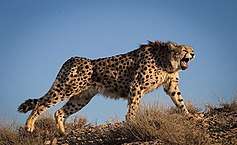
The cheetah thrives in open lands, small plains, semi-desert areas, and other open habitats where prey is available. The Asiatic cheetah mainly inhabits the desert areas around Dasht-e Kavir in the eastern half of Iran, including parts of the Kerman, Khorasan, Semnan, Yazd, Tehran, and Markazi provinces. Most live in five protected areas, viz Kavir National Park, Touran National Park, Bafq Protected Area, Dar-e Anjir Wildlife Refuge, and Naybandan Wildlife Reserve.[6]
During the 1970s, the Asiatic cheetah population in Iran was estimated to number about 200 individuals in 11 protected areas. By the end of the 1990s, the population was estimated at 50 to 100 individuals.[20][21] During camera-trapping surveys conducted across 18 protected areas between 2001 and 2012, a total of 82 individuals in 15–17 families were recorded and identified. Of these, only six individuals were recorded for more than three years. In this period, 42 cheetahs died due to poaching, in road accidents and due to natural causes. Populations are fragmented and known to survive in the Semnan, North Khorasan, South Khorasan, Yazd, Esfahan, and Kerman Provinces.[8]
Former range
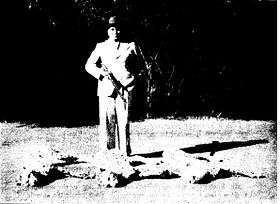
The Asiatic cheetah once ranged from the Arabian Peninsula and Near East to Iran, the Caucasus, Central Asia, Afghanistan, and Pakistan to India.[14][23]
The population in Turkey was extinct already in the 19th century.[24] In Iraq, the cheetah had occurred in the desert west of Basrah, as recently as 1926 (Corkill, 1929). The last recorded Iraqi cheetah was killed by a car between the H1 and H2 pumping stations, then photographed (Harrison and Bates, 1991).[25]
In the Sinai peninsula, a sighting of two cheetahs was reported in 1946. In the Arabian peninsula, the cheetah used to occur in the northern and southeastern fringes. In the north, it had been reported in both Saudi Arabia and Kuwait before 1974. Two Saudi cheetahs were killed near Ha'il in 1973. In the southeast, it occurred in Oman and Yemen. The last known Yemeni cheetah was seen by J. T. Ducker in Wadi Mitan in 1963, and in Oman, a cheetah was shot near Jibjat in 1977.[25]
In Central Asia, uncontrolled hunting of cheetahs and their prey, severe winters and conversion of grassland to areas used for agriculture contributed to the population's decline. Until the early 20th century, the range in Central Asia had decreased significantly.[14] By the 1930s, cheetahs were confined to the Ustyurt plateau and Mangyshlak Peninsula in Kazakhstan and Uzbekistan, and to the foothills of the Kopet Dag mountains and a region in the south of Turkmenistan bordering Iran and Afghanistan. The last known record in this area between the Tejen and Murghab Rivers dates to 1957, in the Ustyurt plateau to July 1983, and in the Kopet Dag to November 1984.[5] Officers of the Badhyz State Nature Reserve did not sight a cheetah in this area until 2014; the border fence between Iran and Turkmenistan might impede dispersal.[26]
The cheetah population in Afghanistan decreased to the extent that it has been considered extinct since the 1950s.[27] Two skins of unknown origin were sighted in markets in the country, one in 1971, and another in 2006.[28]
In India, the cheetah occurred in Rajputana, Punjab, Sind, and south of the Ganges from Bengal to the northern part of the Deccan Plateau. It was also present in the Kaimur District, Darrah and other desert regions of Rajasthan and parts of Gujarat and Central India.[15] Akbar the Great was introduced to cheetahs around the mid-16th century and used them for coursing blackbucks, chinkaras and antelopes. He allegedly possessed 1,000 cheetahs during his reign but this figure is exaggerated since there is neither evidence of housing facilities for so many animals, nor of facilities to provide them with sufficient meat every day.[29] Trapping of adult cheetahs, who had already learned hunting skills from wild mothers, for assisting in royal hunts is said to be another major cause of the species' rapid decline in India as there is only one record of a litter ever born to captive animals. By the beginning of the 20th century, wild Asiatic cheetahs were so rare in India, that between 1918 and 1945, Indian princes imported cheetahs from Africa for coursing. Three of India's last cheetahs were shot by the Maharajah of Surguja in 1948. A female was sighted in 1951 in Koriya district, northwestern Chhattisgarh.[22]
In the 2015 update of the IUCN Red List, the Asiatic cheetah is considered regionally extinct in Iraq, Central Asia, Afghanistan, Pakistan and India.[30]
Ecology and behaviour
Most sightings of cheetahs in the Miandasht Wildlife Refuge between January 2003 and March 2006 occurred during the day and near watercourses. These observations suggest that they are most active when their prey is.[31]
Camera-trapping data obtained between 2009 and 2011 indicate that some cheetahs travel long distances. A female was recorded in two protected areas that are about 150 km (93 mi) apart and intersected by railway and two highways. Her three male siblings and a different adult male were recorded in three reserves, indicating that they have large home ranges.[32]
Diet
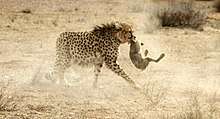
The Asiatic cheetah preys on medium-sized herbivores including chinkara, goitered gazelle, wild sheep, wild goat and cape hare.[33] In Turan Biosphere Reserve, cheetahs use a wide range of habitats, but prefer areas close to water sources. This habitat overlaps to 61% with wild sheep, 36% with onager, and 30% with gazelle.[34]
In India, prey was formerly abundant. Before its extinction in the country, the cheetah fed on the blackbuck, the chinkara, and sometimes the chital and the nilgai.
...is in low, isolated, rocky hills, near the plains on which live antelopes, its principal prey. It also kills gazelles, nilgai, and, doubtless, occasionally deer and other animals. Instances also occur of sheep and goats being carried off by it, but it rarely molests domestic animals, and has not been known to attack men. Its mode of capturing its prey is to stalk up to within a moderate distance of between one to two hundred yards, taking advantage of inequalities of the ground, bushes, or other cover, and then to make a rush. Its speed for a short distance is remarkable far exceeding that of any other beast of prey, even of a greyhound or kangaroo-hound, for no dog can at first overtake an Indian antelope or a gazelle, either of which is quickly run down by C. jubatus, if the start does not exceed about two hundred yards. General McMaster saw a very fine hunting-leopard catch a black buck that had about that start within four hundred yards. It is probable that for a short distance the hunting-leopard is the swiftest of all mammals.
— Blanford writing on the Asiatic cheetah in India quoted by Lydekker[12]
Before the end of the 10th Century, in the Trans-Caucasus, when conditions were different, numbers of ungulates like Roe deer and wild boars were large enough to sustain predators like the Asiatic lion and cheetah. Eventually, when the number of humans increased, and environmental conditions changed, the number of ungulates dwindled, thus adversely affecting predators, though the Caspian tiger managed to survive there up to the 20th Century, and the Persian leopard still occurs there. The cheetah may have survived in the Trans-Caucasus up to the 13th Century (Vereshchagin, 1952; Avaliani, 1965).[14]
Reproduction

Evidence of females successfully raising cubs is very rare. A few observations in Iran indicate that they give birth throughout the year to one to four cubs. In April 2003, four cubs were found in a den that had their eyes still closed. In November 2004, a cub was recorded by a camera-trap that was about 6–8 months old. Breeding success depends on availability of prey.[31] In January 2008, a male cub aged about 7–8 months was recovered from a sheep herder and brought into captivity.[35]
In October 2013, conservationists from the Persian Wildlife Heritage Foundation filmed a mother with four cubs in Khar Turan National Park.[36] In December 2014, four cheetahs were sighted and photographed by camera traps in the same national park.[37] In January 2015, three other adult Asiatic cheetahs and a female with her cub were sighted in Miandasht Wildlife Refuge.[38] Eleven cheetahs were also sighted at the time, and another four a month later.[39] In July 2015, five adult cheetahs and three cubs were spotted in Khar Turan National Park.[40]
The Asiatic cheetah population is considered to be on the rise.[41] In December 2015, it is reported that 18 new Asiatic cheetah cubs had recently been born and it was hoped for two captive Asian cheetahs at Pardisan Park would produce cubs.[42]
Threats

The Asiatic cheetah has been listed as Critically Endangered on the IUCN Red List since 1996.[1] Following the Iranian Revolution of 1979, wildlife conservation was interrupted for several years. Manoeuvres with armed vehicles were carried in steppes, and local people hunted cheetahs and prey species unchecked. The gazelle population declined in many areas, and cheetahs retreated to remote mountainous habitats.[6][31]
Reduced gazelle numbers, persecution, land-use change, habitat degradation and fragmentation, and desertification contributed to the decline of the cheetah population.[20][43] The cheetah is affected by loss of prey as a result of antelope hunting and overgrazing from introduced livestock. Its prey was pushed out as herders entered game reserves with their herds.[33] A herder pursued a female cheetah with two cubs on his motorbike, until one of the cubs was so exhausted that it collapsed. He caught and kept it chained in his home for two weeks, until it was rescued by officers of the Iranian Department of Environment.[35]
Mining development and road construction near reserves also threaten the population.[20] Coal, copper, and iron have been mined in cheetah habitat in three different regions in central and eastern Iran. It is estimated that the two regions for coal (Nayband) and iron (Bafq) have the largest cheetah population outside protected areas. Mining itself is not a direct threat to the population; road construction and the resulting traffic have made the cheetah accessible to humans, including poachers. The Iranian border regions to Afghanistan and Pakistan, viz the Baluchistan Province, are major passages for armed outlaws and opium smugglers who are active in the central and western regions of Iran, and pass through cheetah habitat. Uncontrolled hunting throughout the desert cannot be effectively controlled by the governments of the three countries.[20]
Conflict between livestock herders and cheetahs is also threatening the population outside protected areas. Several herders killed cheetahs to prevent livestock loss, or for trophies, trade and fun.[43] Some herders are accompanied by large mastiff-type dogs into protected areas. These dogs killed five cheetahs between 2013 and 2016.[44]
Between 2007 and 2011, six cheetahs, 13 predators and 12 Persian gazelles died in Yazd Province following collisions with vehicles on a transit road.[45] At least 11 Asiatic cheetahs were killed in road accidents between 2001 and 2014.[7] The road network in Iran constitutes a very high risk for the small population as it impedes connectivity between population units.[46] Efforts to stop the construction of a road through the core of the Bafq Protected Area were unsuccessful.[47]
Conservation efforts
In September 2001, the project "Conservation of the Asiatic Cheetah and its Associated Biota" was launched by the Iranian Department of Environment (DoE) in cooperation with the United Nations Development Programme's Global Environment Facility, the Wildlife Conservation Society (WCS), the IUCN Cat Specialist Group, the Cheetah Conservation Fund and the Iranian Cheetah Society.[6]
Personnel of WCS and DoE started radio-collaring Asiatic cheetahs in February 2007. The cats' movements are monitored using GPS collars.[48][49] International sanctions have made some projects, such as obtaining camera traps, difficult.[36]
A few orphaned cubs have been raised in captivity, such as Marita who died at the age of nine years in 2003. Beginning in 2006, the day of his death, 30 August, became the Cheetah Conservation Day, used to inform the public about conservation programs.[50][49][51][52]
In 2014, the Iranian national football team announced that their 2014 FIFA World Cup and 2015 AFC Asian Cup kits are imprinted with pictures of the Asiatic cheetah in order to bring attention to conservation efforts.[10] In February 2015, Iran launched a search engine, Yooz, that features a cheetah as logo.[53] In May 2015, the DoE announced plans to quintuple the penalty for poaching a cheetah to 100 million tomans (about $30,000).[54] In September 2015, Meraj Airlines introduced the new livery of Iranian Cheetah to support its conservation efforts.[55] Iranian officials have discussed constructing wildlife crossings to reduce the number of deaths in traffic accidents.[50]
Projects
Training course for herders: It was estimated that ten cheetahs live in the Bafq Protected Area. According to the Iranian Cheetah Society (ICS), herders are considered as a significant target group which generally confuses the cheetah with other similar-sized carnivores, including wolf, leopard, striped hyena, and even caracal and wild cat. On the basis of the results of conflict assessment, a specific Herders Training Course was developed in 2007, in which they learned how to identify the cheetah as well as other carnivores, since these were the main causes for livestock kills. These courses were a result of cooperation between UNDP/GEF, Iran’s Department of Environment, ICS, and the councils of five main villages in this region.
Cheetah Friends: Another incentive in the region is the formation of young core groups of Cheetah Friends, who after a short instructive course, are able to educate people and organize cheetah events and become an informational instance in cheetah matters for a number of villages. Young people have expressed growing interest in the issue of cheetah and other wildlife conservation.
Ex-situ conservation: India, where the Asiatic cheetah is now extinct, is interested in cloning the cheetah to reintroduce it to the country.[56] It was claimed that Iran – the donor country – was willing to participate in the project.[57] Later, however, Iran refused to send a male and female cheetah or to allow experts to collect tissue samples from a cheetah kept in a zoo there.[58] In 2009, the Indian government considered reintroducing cheetahs through importing from Africa through captive breeding.[59]
In 2014, an Asiatic cheetah was cloned for the first time by scientists from the University of Buenos Aires.[60] The embryo was not born.[61]
Semi-captive breeding
_04.jpg)
In February 2010, Mehr News Agency, Payvand Iran News released the photos of an Asiatic/Iranian cheetah in a seemingly large compound within natural habitat enclosed by chain link fence, this location was reported in this news article to be the "Semi-Captive Breeding and Research Center of Iranian Cheetah" in Iran's Semnan province. The Asiatic cheetah pictured had a winter coat with longer fur.[62] Another news report stated that the centre is home to about ten Asiatic cheetahs in a semi-wild environment protected by wire fencing all around.[63]
Wildlife officials in Miandasht Wildlife Refuge and the Turan National Park have raised a few orphaned cubs.[49] In May 2014, officials said they would bring together a pair of grown individuals in the hope they would produce cubs, while acknowledging that cheetahs are difficult to breed.[64]
In March 2015, a pair of adult male and female Asiatic cheetahs are part of a captive breeding project somewhere close to the Milad tower in Tehran for the first time.[65]
Re-introduction proposals
Cheetahs have been known to exist in India for a very long time, but hunting led to their extinction in the country in the late 1940s.[22] The Indian government planned to reintroduce cheetahs to India. The IUCN's Species Survival Commission has approved a feasibility study, stressing to follow the IUCN guidelines on reintroduction and introducing the same subspecies, if and when the reasons for extinction have been removed.[66] Then Minister of Environment and Forests, Jairam Ramesh, told the Rajya Sabha on 7 July 2009 that "The cheetah is the only animal that has been described extinct in India in the last 100 years. We have to get them from abroad to repopulate the species." He was responding to a notice from the Bharatiya Janata Party. "The plan to bring back the cheetah which fell to indiscriminate hunting and complex factors like a fragile breeding pattern is audacious given the problems besetting tiger conservation." Two naturalists suggested the idea of importing the South African cheetahs from Namibia, breeding them in captivity in India and release their offspring into the wild.
In September 2009, international biologists, representatives from the Wildlife Institute of India and Indian politicians held a meeting about cheetah reintroduction in India. During this meeting, it was decided to conduct a feasibility study and assess 10 sites located in Rajasthan, Gujarat, Madhya Pradesh, Uttar Pradesh and Chhattisgarh. The survey members proposed Kuno-Palpur Wildlife Sanctuary, Shahgarh Landscape and Nauradehi Wildlife Sanctuary as potential reintroduction sites, if resources and personnel for habitat restoration, fencing, relocation of about 80 human settlements and the establishment of a compensation system for livestock loss can be allocated. They suggested to source cheetahs from either Iran or Africa, and hoped that the revenues generated from tourism at reintroduction sites would increase substantially.[67] In 2012, India's Supreme Court suspended attempts to introduce African cheetahs when new genetic evidence suggested that the Asiatic and African cheetahs separated between 32,000 and 67,000 years ago. The government tried reviving the project in 2014, but to no avail.[68]
Gallery
 South Asian Nawabs with cheetahs
South Asian Nawabs with cheetahs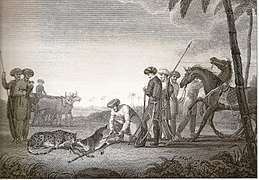 Hunting of the blackbuck with the cheetah; drawn by James Forbes in South Gujarat, Western India. Oriental Memoirs, 1812.
Hunting of the blackbuck with the cheetah; drawn by James Forbes in South Gujarat, Western India. Oriental Memoirs, 1812. Coat of arms of former Kolhapur State with two Asiatic cheetahs proper as supporters
Coat of arms of former Kolhapur State with two Asiatic cheetahs proper as supporters
See also
References
- 1 2 3 Jowkar, H.; Hunter, L.; Ziaie, H.; Marker, L.; Breitenmoser-Würsten, C. & Durant, S. (2008). "Acinonyx jubatus ssp. venaticus". IUCN Red List of Threatened Species. Version 2015.2. International Union for Conservation of Nature.
- ↑ Wozencraft, W.C. (2005). "Order Carnivora". In Wilson, D.E.; Reeder, D.M. Mammal Species of the World: A Taxonomic and Geographic Reference (3rd ed.). Johns Hopkins University Press. p. 532. ISBN 978-0-8018-8221-0. OCLC 62265494.
- ↑ Masseti, M. (2009). "Carnivores of Syria". In Neubert, E.; Amr, Z.; Taiti, S.; Gümüs, B. Animal Biodiversity in the Middle East. Proceedings of the First Middle Eastern Biodiversity Congress, Aqaba, Jordan, 20–23 October 2008. ZooKeys 31. pp. 229–252.
- 1 2 Nowell, K. and Jackson, P. (1996). "Cheetah Acinonyx jubatus Schreber, 1776". Wild Cats. Status Survey and Conservation Action Plan. IUCN/SSC Cat Specialist Group, Gland.
- 1 2 Mallon, D. P. (2007). "Cheetahs in Central Asia: A historical summary" (PDF). Cat News (46): 4–7.
- 1 2 3 4 Farhadinia, M.S. (2004). "The last stronghold: cheetah in Iran" (PDF). Cat News. 40: 11–14.
- 1 2 Farhadinia, M.S., Eslami, M., Hobeali, K., Hosseini-Zavarei, F., Gholikhani, N. & Tak Tehrani, A. (2014). Status of Asiatic cheetah in Iran: A country-scale assessment. Report to People’s Trust for Endangered Species. Tehran: Iranian Cheetah Society.
- 1 2 Farhadinia, M.S., Hunter, L.T., Jourabchian, A., Hosseini-Zavarei, F., Akbari, H., Ziaie, H., Schaller, G.B. and Jowkar, H. (2017). "The critically endangered Asiatic cheetah Acinonyx jubatus venaticus in Iran: a review of recent distribution, and conservation status". Biodiversity and Conservation. 26 (5): 1–20. doi:10.1007/s10531-017-1298-8.
- ↑ Khalatbari, L., Jowkar, H.,Yusefi, G. H., Brito, J. C., Ostrowski, S. (2017). "The current status of Asiatic cheetah in Iran". Cat News. 66: 10−13.
- 1 2 3 "FIFA confirms depiction of Asiatic Cheetah on Iran jersey". Persian Football. 1 February 2014.
- 1 2 Charruau, P.; Fernandes, C.; Orozco-Terwengel, P.; Peters, J.; Hunter, L.; Ziaie, H.; Jourabchian, A.; Jowkar, H.; Schaller, G.; Ostrowski, S. (2011). "Phylogeography, genetic structure and population divergence time of cheetahs in Africa and Asia: evidence for long-term geographic isolates". Molecular Ecology. 20 (4): 706–724. doi:10.1111/j.1365-294X.2010.04986.x. PMC 3531615. PMID 21214655.
- 1 2 Lydekker, R. A. (1894). The Royal Natural History. 1. London, New York: Frederick Warne & Company.
- ↑ Hollister, N. (1911). "The nomenclature of the Cheetahs". Proceedings of the Biological Society of Washington. 24: 225–226.
- 1 2 3 4 Geptner, V. G., Sludskij, A. A. (1992) [1972]. "Cheetah, Pardus". Mlekopitajuščie Sovetskogo Soiuza. Moskva: Vysšaia Škola [Mammals of the Soviet Union. Volume II, Part 2. Carnivora (Hyaenas and Cats)]. Washington DC: Smithsonian Institution and the National Science Foundation. pp. 702–733.
- 1 2 Pocock, R. I. (1939). "Acinonyx jubatus". The Fauna of British India, including Ceylon and Burma. Mammalia. – Volume 1. London: Taylor and Francis Ltd. pp. 324–330.
- ↑ Hildebrand, M. (1959). "Motions of the running cheetah and horse". Journal of Mammalogy. 40 (4): 481–495. doi:10.2307/1376265.
- ↑ Taylor, C. R.; Rowtree, V. J. (1973). "Temperature regulation and heat balance in running cheetahs: a strategy for sprinters?". American Journal of Physiology. 224: 848–852. doi:10.1152/ajplegacy.1973.224.4.848.
- 1 2 Hetem, R.; Mitchell, D.; de Witt, B. A.; Fick, L. G.; Meyer, L. C. R.; Maloney, S. K.; Fuller, A. (2013). "Cheetah do not abandon hunts because they overheat". Biology Letters. 9 (5): 1–5. doi:10.1098/rsbl.2013.0472. PMC 3971684.
- ↑ Phillips, J. A. (1993). "Bone consumption by cheetahs at undisturbed kills: evidence for a lack of focal-palatine erosion". Journal of Mammalogy. 74: 487–492. doi:10.2307/1382408.
- 1 2 3 4 Asadi, H. (1997). The environmental limitations and future of the Asiatic cheetah in Iran. Unpublished project progress report (PDF). IUCN Iran.
- ↑ Jourabchian, A.R., Farhadinia, M.S. (2008). Final report on Conservation of the Asiatic cheetah, its natural habitats and associated biota in Iran. Project Number IRA/00/G35 (GEF/UNDP/DoE), Tehran, Iran.
- 1 2 3 Divyabhanusinh (1999). The End of a Trail: the Cheetah in India. Banyan Books, New Delhi.
- ↑ Qumsiyeh, M. B. (1996). "Genus Acinonyx Cheetah". Mammals of the Holy Land. Lubbock: Texas Tech University Press. pp. 157–159. ISBN 089672364X.
- ↑ Kryštufek, B. and V. Vohralík. (2001). Mammals of Turkey and Cyprus: Introduction, Checklist, Insectivora. Knjižnica Annales Majora, Koper, Republic of Slovenia.
- 1 2 Nowell, K., Jackson, P. (1996). "Asiatic cheetah". Wild Cats: Status Survey and Conservation Action Plan (PDF). Gland, Switzerland: IUCN/SSC Cat Specialist Group. pp. 41–44. ISBN 2-8317-0045-0.
- ↑ Kaczensky, P. and Linnell, J. D. C. (2014). Rapid assessment of the mammalian community of the Badhyz Ecosystem, Turkmenistan, October 2014. NINA Report 1148. Trondheim: Norwegian Institute for Nature Research.
- ↑ Habibi, K. (2003). Mammals of Afghanistan. Coimbatore, India: Zoo Outreach Organisation, USFWS.
- ↑ Manati, A.R. and Nogge, G. (2008). "Cheetahs in Afghanistan". Cat News (49): 18.
- ↑ Thapar, V.; Thapar, R.; Ansari, Y. (2013). Exotic Aliens: The Lion and the Cheetah in India. New Delhi: Aleph Book Company.
- ↑ Durant, S., Mitchell, N., Ipavec, A. & Groom, R. (2015). "Acinonyx jubatus". The IUCN Red List of Threatened Species. IUCN. 2015: e.T219A50649567. doi:10.2305/IUCN.UK.2015-4.RLTS.T219A50649567.en. Retrieved 13 January 2018.
- 1 2 3 Farhadinia, M.S. (2007). Ecology and conservation of the Asiatic cheetah in Miandasht Wildlife Refuge, Iran. Tehran: Iranian Cheetah Society.
- ↑ Farhadinia, M.S., Akbari, H., Mousavi, S.J., Eslami, M., Azizi, M., Shokouhi, J., Gholikhani, N. and Hosseini-Zavarei, F. (2013). "Exceptionally long movements of the Asiatic cheetah Acinonyx jubatus venaticus across multiple arid reserves in central Iran". Oryx. 47 (3): 427–430. doi:10.1017/S0030605313000641.
- 1 2 Farhadinia, M.S.; Hosseini-Zavarei, F.; Nezami, B.; Harati, H.; Absalan, H.; Fabiano, E.; Marker, L. (2012). "Feeding ecology of the Asiatic cheetah Acinonyx jubatus venaticus in low prey habitats in northeastern Iran: Implications for effective conservation". Journal of Arid Environments. 87: 206–211. doi:10.1016/j.jaridenv.2012.05.002.
- ↑ Nazeri, M., Madani, N., Kumar, L., Mahiny, A.S. and Kiabi, B.H. (2015). "A geo-statistical approach to model Asiatic cheetah, onager, gazelle and wild sheep shared niche and distribution in Turan biosphere reserve-Iran". Ecological Informatics (29): 25–32.
- 1 2 Jowkar, H., Ostrowski, S., Hunter, L. (2008). Asiatic Cheetah cub recovered from a poacher in Iran. Cat News 48: 13.
- 1 2 Dehghan, S. K. (23 October 2013). "Cheetahs' Iranian revival cheers conservationists". TheGuardian.com.
- ↑ "Camera traps capture 4 new Asiatic Cheetahs in Iran". Mehr News Agency. 28 December 2014.
- ↑ "Female Asiatic Cheetah, cub sighted in Miandasht". Mehr News Agency. 7 January 2015.
- ↑ "Female Asiatic cheetah, 3 cubs sighted in Turan National Park". mehrnews.com. 21 January 2015. Retrieved 6 July 2015.
- ↑ "8 Asiatic cheetahs spotted in Shahroud". mehrnews.com. 3 July 2015. Retrieved 3 July 2015.
- ↑ "UNDP Iran releases Asiatic Cheetah PSA". ir.undp.org. 2015. Retrieved 20 June 2015.
- ↑ "Asiatic cheetah extinction trend reversed". Payvand Iran News. 7 December 2015. Retrieved 8 December 2015.
- 1 2 Rastegar, H. (2009). "Biodiversity of last Asiatic Cheetahs (Acinonyx jubatus venaticus) in Bafgh and Ariz Protected Area, Iran". Journal of Environmental Research and Development. 3 (3): 639–644.
- ↑ Croke, V. (2016). "Saving the desert Cheetahs of Iran". WBUR.
- ↑ Mohammadi, A. and Kaboli, M. (2016). Evaluating wildlife-vehicle collision hotspots using kernel-based estimation: a focus on the endangered Asiatic cheetah in central Iran. Human-Wildlife Interactions 10 (1): 103–109.
- ↑ Moqanaki, E.M. and Cushman, S.A. (2017). "All roads lead to Iran: predicting landscape connectivity of the last stronghold for the critically endangered Asiatic cheetah". Animal Conservation. 20 (1): 29–41. doi:10.1111/acv.12281.
- ↑ Niayesh, Umid (8 November 2013). "Iranian Cheetahs remain endangered – expert (PHOTO) (VIDEO)". trend.az.
- ↑ Hunter, L., Jowkar, H., Ziaie, H., Schaller, G., Balme, G., Walzer, C., Ostrowski, S., Zahler, P., Robert-Charrue, N., Kashiri, K. and Christie, S. (2007). Conserving the Asiatic cheetah in Iran: launching the first radio-telemetry study. Cat News 46: 8–11.
- 1 2 3 Karimi, Nasser (26 June 2014). "Iran tries to save Asiatic cheetah from extinction". Associated Press. Archived from the original on 11 December 2014.
- 1 2 Mostaghim, R.; Bengali, S. (29 September 2016). "The world's fastest animal is in a race for survival in Iran". Los Angeles Times.
- ↑ Rohani, Bijan (3 September 2013). "Iranian Cheetah Conservation Day". Payvand.
- ↑ "FIFA chief green-lights Iranian cheetah logo for Iran team jersey". Tehran Times. 9 November 2013. Archived from the original on 11 November 2013.
- ↑ Sridharan, Vasudevan (16 February 2015). "Iran launches own search engine Yooz to beat internet-related sanctions". International Business Times.
- ↑ "Iran multiplies fines for poachers". Tehran Times. 25 May 2015.
- ↑ "Efforts to save the Iranian cheetah take off!". euronews.com. 18 September 2015.
- ↑ Pros and Cons of inbreeding – See footnotes on page
- ↑ Singh, L. (2003). Project to Clone Extinct Cheetah Gets a Boost. www.cabi.org
- ↑ "Mullas' regime says "No" to cloning of cheetah". 9 July 2005. Archived from the original on 19 November 2007.
- ↑ "Extinct in India, Cheetah may be imported". The Times Of India. 8 July 2009.
- ↑ Moro, L. N., Veraguas, D., Rodriguez-Alvarez, L., Hiriart, M. I., Buemo, C., Sestelo, A., & Salamone, D. (2015). 212 Interspecific Clonong and Embryo Aggregation influence the Expression of oct4, nanog, sox2, andcdx2 in Cheetah and Domestic Cat Blastocysts. Reproduction, Fertility and Development 27(1): 196–196.
- ↑ Xiang, B. (2015). Argentine scientists clone endangered Asiatic Cheetahs for first time. Xinhua, english.news.cn
- ↑ "Photos: Saving the Iranian Cheetah from Extinction; Photos by Yuness Khani". Mehr News Agency. Payvand Iran News. 10 February 2010.
- ↑ "Asiatic Cheetah on The Brink of Extinction – Less Than one Hundred Asiatic Cheetahs Survive in the World". Hamsayeh.net. 27 February 2010.
- ↑ Gaeini, M.; Habibinia, O. (14 May 2014). "Courting endangered cheetahs capture Iranian hearts". France24.com. Archived from the original on 16 May 2014.
- ↑ "Two endangered cheetahs in Tehran for conservation project". PressTV.ir. 19 March 2015. Retrieved 13 May 2015.
- ↑ Jackson, P.F.R. (1985). "Cheetah reintroduction—more to add". Oryx. 19 (3): 167. doi:10.1017/s0030605300025357.
- ↑ Ranjitsinh, M.K. and Jhala, Y.V. (2010). Assessing the potential for reintroducing the cheetah in India. Wildlife Trust of India, Noida, and Wildlife Institute of India, Dehradun.
- ↑ Kazmi, R. (2016). Where the Wild Things Were. The Indian Express.
External links
| Wikispecies has information related to Acinonyx jubatus venaticus |
| Wikimedia Commons has media related to Acinonyx jubatus venaticus. |
- Species portrait Asiatic cheetah; IUCN/SSC Cat Specialist Group
- Iranian Cheetah Society – A non-profit organisation set up to save the Asiatic cheetah.
- Asiatic Cheetah Project – Felidae Conservation Fund, USA
- Cheetah Conservation Fund
- Iran Department of Environment
- Video: Hunting with Cheetahs in India on YouTube
- Video: 'Cheetahs in Iran', the last stronghold of the Asiatic cheetah on YouTube
- Video: Extinctions : Discover the endangered Asiatic cheetah on YouTube
- ScienceDaily 2011: The Need for Conservation of Asiatic Cheetahs
- The Persian Cheetah
- Spotted big cat in Turkmenistan
- Asiatic cheetah embryos cloned at Royan Institute
